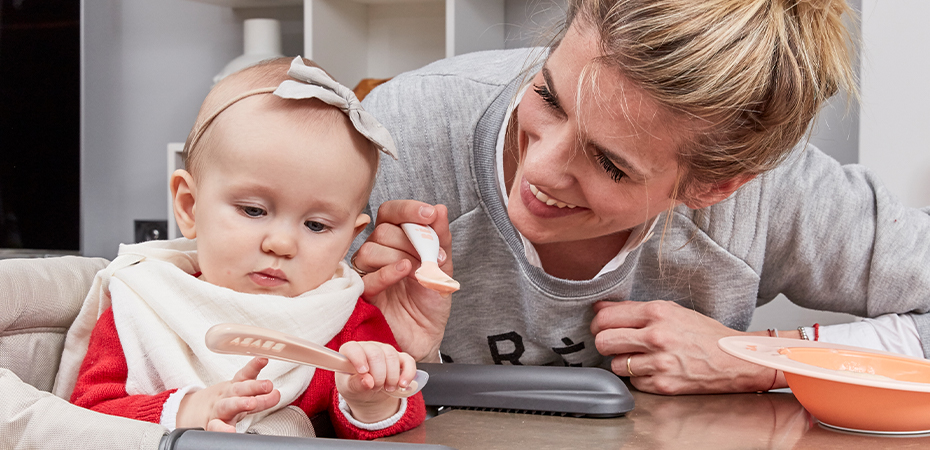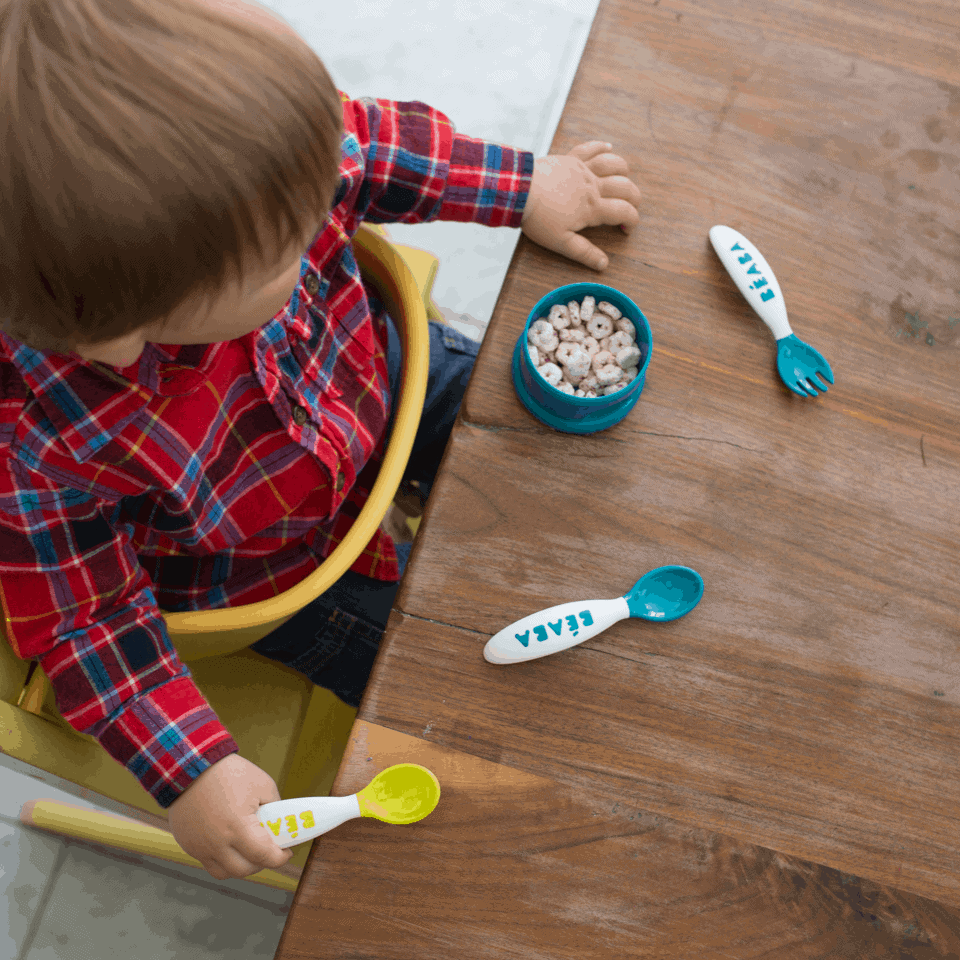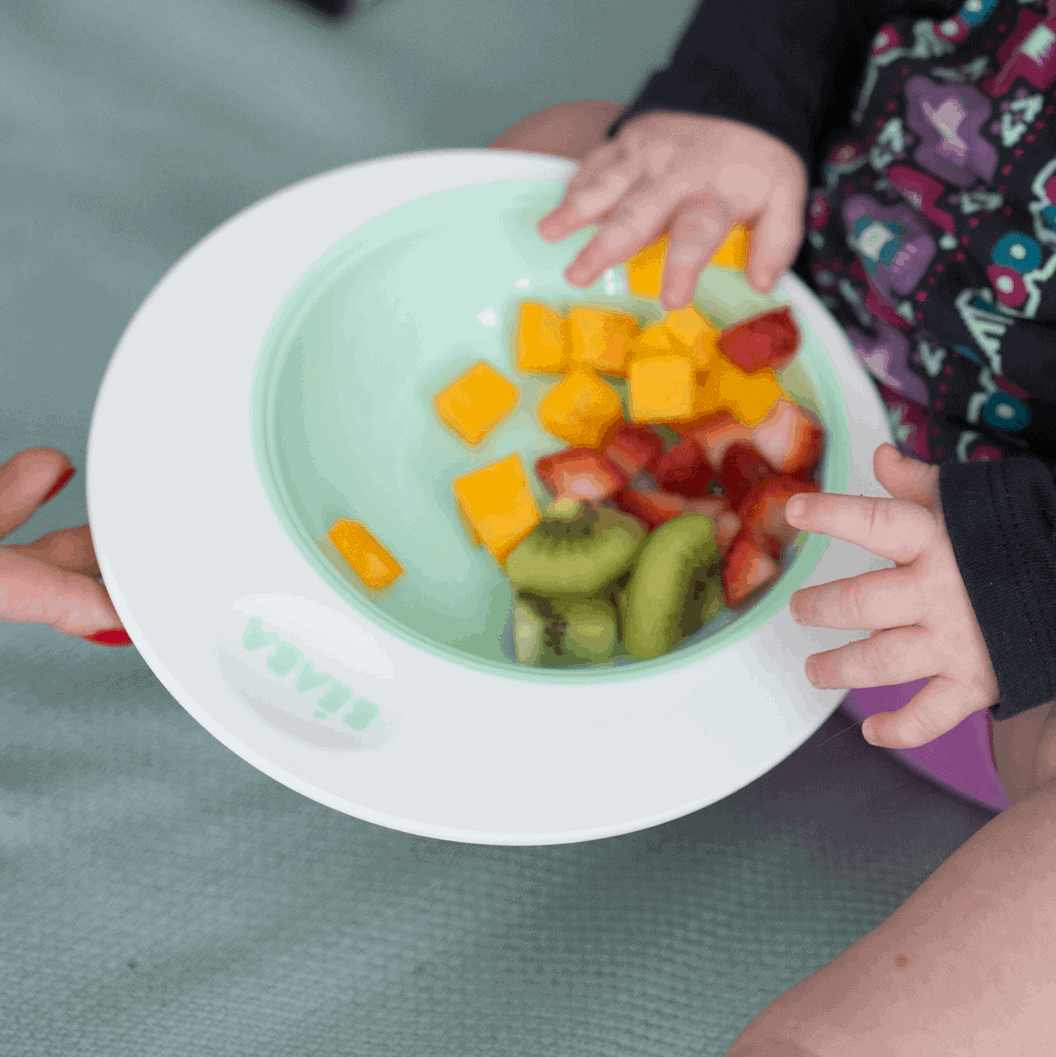
Progressing Through the Stages of Solids
As you introduce your baby to solid foods, the type and texture of the foods you offer will change as they grow. In the beginning, you will want to start with single-ingredient purées, with a very thin, almost watery consistency. As your baby progresses, you will start to thicken your purées more and add more ingredients. Eventually, you will forgo the smooth purées and move on to chunkier purées. Instead of using your blender or food processor, you’ll start mashing your ingredients together with a fork or potato masher to get your baby accustomed to new textures. Finally, your baby will move on to table food, which can be chopped into bite-size pieces.
4–6 Months
When your baby first begins solids, you will start out giving them single ingredient foods like single grain cereals, vegetables or fruit purées. Starchy, sweet vegetables like sweet potatoes, squash and peas are all good choices. Mild, low-acid fruits like apple and pear also make for nice options. Or, if you prefer, you can start with a simple, no-cook purée like avocado or banana.
Thin your purées as needed with breast milk or formula. For the first few feedings, begin with a few teaspoons of food. As your baby gets used to the idea of eating from a spoon, the teaspoons will soon turn to tablespoons.
6–9 Months
 Continue giving your baby a wide variety of single purées, and start combining them to broaden their palate. You can begin to introduce all sorts of fruits, like peaches, cherries and melons. Include different colored vegetables, like green beans, cauliflower and beets. You can also introduce puréed meat like beef, chicken, turkey or lamb, which are all good sources or iron, a critical mineral that your baby needs at this age. You can also introduce beans and legumes like black beans, lentils and split peas, which are high in protein and iron. While you should still hold off on cow’s milk until your baby is 1 year old, you can introduce yogurt, eggs and some cheese (like cottage cheese and cheddar), which are more easily tolerated.
Continue giving your baby a wide variety of single purées, and start combining them to broaden their palate. You can begin to introduce all sorts of fruits, like peaches, cherries and melons. Include different colored vegetables, like green beans, cauliflower and beets. You can also introduce puréed meat like beef, chicken, turkey or lamb, which are all good sources or iron, a critical mineral that your baby needs at this age. You can also introduce beans and legumes like black beans, lentils and split peas, which are high in protein and iron. While you should still hold off on cow’s milk until your baby is 1 year old, you can introduce yogurt, eggs and some cheese (like cottage cheese and cheddar), which are more easily tolerated.
As you expand your baby’s palate, make sure to introduce new ingredients one at a time to watch for any adverse reactions. Start using herbs and spices to flavor your baby’s food—baby food does not have to be bland!
9–12 Months
 As your baby gets older, they will become better at chewing so you can start making food with a lumpier, mashed consistency, rather than smooth purées. You can also start introducing finely minced meat (as tolerated) instead of puréed. Although babies won’t develop their molars until around 1 year, they are very effective at mashing food between their gums. Start giving your baby combination meals, which combine fruits, vegetables, proteins, grains and dairy.
As your baby gets older, they will become better at chewing so you can start making food with a lumpier, mashed consistency, rather than smooth purées. You can also start introducing finely minced meat (as tolerated) instead of puréed. Although babies won’t develop their molars until around 1 year, they are very effective at mashing food between their gums. Start giving your baby combination meals, which combine fruits, vegetables, proteins, grains and dairy.
By 8–10 months, infants begin to develop the pincer grasp, which lets them pick up objects between their thumb and forefinger. You can now start introducing finger foods like cooked, soft pieces of carrots or sweet potato, O-shaped cereal, small pieces of ripe pear or peach, small pasta, or scrambled eggs.
12-18 Months

 Your little one has now been introduced to all of the different foods groups, and has quite a bit of experience under their belt! If you haven’t done so already, pull their chair up to the table so that they can participate in family meals. At this age, they can eat table food that is cut into small pieces, like pasta, stews and quesadillas. Encourage self-feeding with utensils and start phasing out formula and baby purées. You can now introduce ingredients like cow’s milk and honey. Continue to offer your baby, as well as the rest of the family, a wide variety of textures, tastes and food experiences. Around this age, you can start offering 2–3 nutritious snacks a day in addition to meals.
Your little one has now been introduced to all of the different foods groups, and has quite a bit of experience under their belt! If you haven’t done so already, pull their chair up to the table so that they can participate in family meals. At this age, they can eat table food that is cut into small pieces, like pasta, stews and quesadillas. Encourage self-feeding with utensils and start phasing out formula and baby purées. You can now introduce ingredients like cow’s milk and honey. Continue to offer your baby, as well as the rest of the family, a wide variety of textures, tastes and food experiences. Around this age, you can start offering 2–3 nutritious snacks a day in addition to meals.
18 Months +

With age comes increasing independence. Your little one may soon become more interested in walking and exploring than sitting still and eating. Toddlers’ eating habits are notoriously unpredictable, but try to eat together as a family as often as possible. If your little ones see the rest of the family enjoying their food, it will encourage them to eat. Also, it’s okay to let them play with their food—eating should be an enjoyable experience, and playing with their food is a totally normal way for babies to learn to accept foods that are new and different. Don’t worry if your toddler doesn’t eat consistent amounts at every meal. Although this may be frustrating, it is completely normal. Over time, they will get all the nutrients they need to grow.
For more information about starting your baby on solids including detailed feeding schedules, refer to Dr. Ruder’s book: Natural Baby Food: 150 Wholesome, Nutritious Recipes For Your Baby and Toddler.
